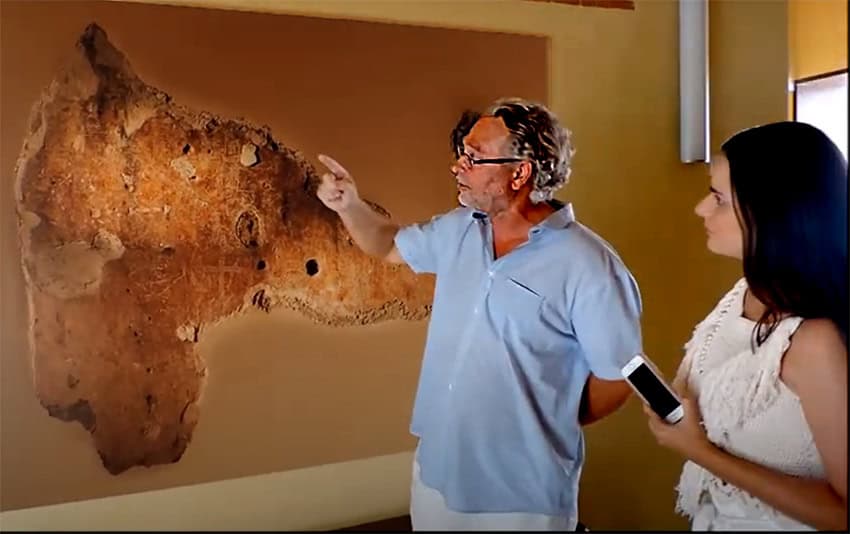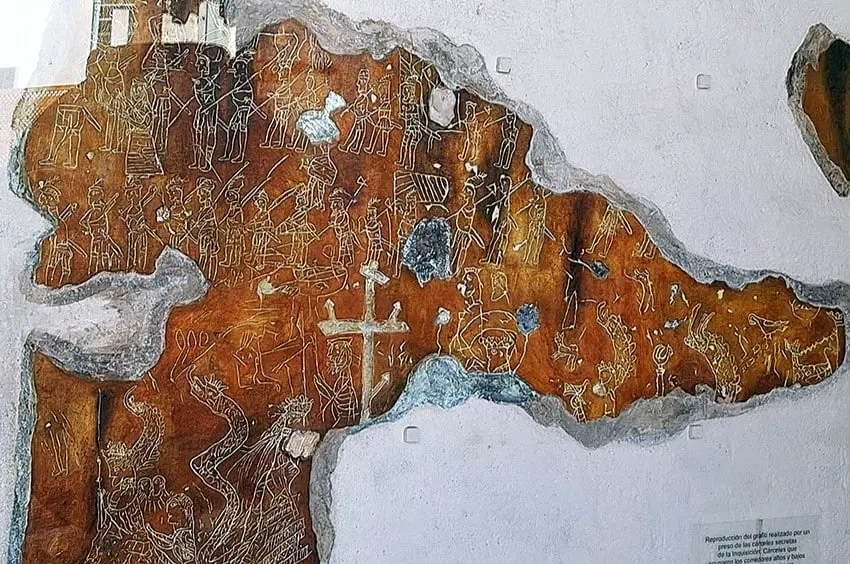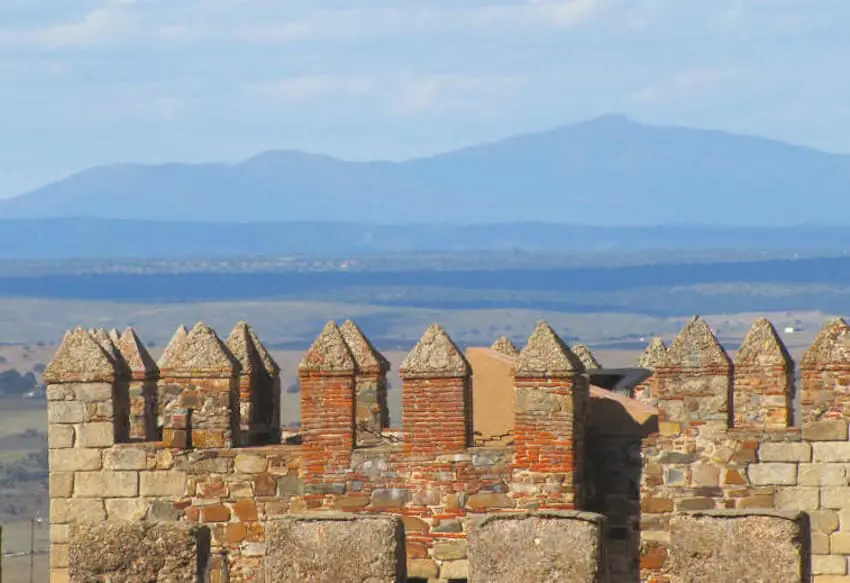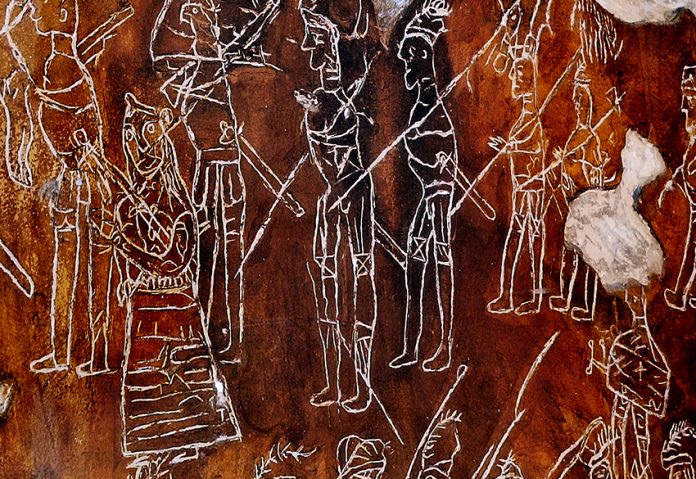Who was the so called “Prisoner of Llerena,” an unfortunate prisoner detained by the Spanish government for crimes against the church? Recently, I stumbled upon a Facebook thread discussing the meaning of candlelight drawings scratched on the wall of a Spanish Inquisition jail cell in the early 1500s.
The sponsor of this conversation, an organization called Ruta Conquistadores, had published photos of the “mural” which had been copied and made available for public viewing in the Museo Histórico de Llerena, a small town in Spain’s Extremadura region.

The drawings seem to show Spanish soldiers, native Mexicans and several huge snakes possibly adorned with feathers.
Quetzalcoatl in the calaboose
Who might have been drawing conquistadores and Quetzalcoatl on the wall of a Spanish calaboose at such an early date?
Fortunately, I was able to contact Luisma Domínguez, director of Ruta Conquistadores, who kindly passed on to me explanations of the curious drawings, by local historian Manuel Toro and archivist Francisco Mateos:
“We see a great many Spanish soldiers, which may represent Hernán Cortés and his men. Among them walks a woman who may be La Malinche. There is a very large cross and below it a figure that I suppose is the author of the mural. There are birds and animals in the drawing and some huge serpents. Since we have only small snakes in Spain, I suppose all these things represent scenes in America, perhaps drawn by a soldier from this region, Extremadura, who ran afoul of the Inquisition.”
Domínguez thinks the Prisoner of Llerena may have been one of the 500 Spaniards who accompanied Cortés to America, “but one who had a problem. He might have been a Jew, a false convert, and when he came back to Spain, they put him in this prison.”

Prisoner of the Spanish Inquisition
“We see the author of this mural at the foot of the cross as a penitent,” says Domínguez, “realizing that he had to pay for his sin. But he appears to have drawn his own image twice. This has been interpreted to mean that he portrays himself as a Christian but deep down he is really a Jew. At some point in the New World, they must have discovered that he was a false convert and such was a person the Inquisition was after.”
Finding a conquistador in this part of Spain is not surprising, says Domínguez. “Almost all of Cortés’ men were born around here, within a circle about 100 kilometers in diameter. Soldiering was one of the main ways of life in Extremadura and once the Moors were driven out, most men were out of work… but then, America was discovered!”
The mural was quietly unveiled to the public seven years ago and since then a few Spanish historians and archaeologists have weighed in on just what it is.
I could, however, find no comments by experts in the New World, so I asked Luisma Domínguez for high-resolution photos of the drawings, which he sent me within a day. These I then forwarded to Mexican archaeologist Francisco Sánchez who specializes in the Pre-Hispanic ideographic tradition: how the Indigenous people transmitted information via images.

A man named Snake
Sánchez immediately drew my attention to the lower left part of the drawing where we see a person wearing a crown with what appears to be a serpent attached to his head. “This,” he said, “is what is called a Name Glyph in the codices. It’s this figure’s name. It could be Quetzalcoatl, but there are many individuals whose names are related to a snake. Immediately behind this figure, we see what looks like two people kissing, but in reality, this is a symmetric face, a face seen from the front, but you have to see it close up. The two silhouettes form the nose, and the eyes in the two profiles are the eyes seen from the front. This is something very pre-Hispanic. We don’t know who that prisoner was, or where he was from, but one thing I can tell you for sure is that this was a person who had knowledge of what we call the Mixteca-Puebla iconographic tradition, found in the center of Mexico.”
Pre-Hispanic imagery
Sánchez pointed out that photos of the original wall show it very deteriorated. “So, when they did the restoration, they decided what was original and what was added later, and this they discarded. This influences the interpretation — but the snakes are pre-Hispanic without a doubt. A Spaniard could not have drawn them.”
So who made these images? Who was the Prisoner of Llerena?
Sánchez explained to me that in those days a favorite method of getting someone in the New World out of the way — without killing them — was to send them off to Spain and put them into what were called “secret” or “perpetual” jails, maintained by the Inquisition. One example is Nuño de Guzmán who died in such a jail cell, awaiting a royal audience which was never granted.
The unknown fate of Tenamaxtle
“The Spaniards also carried many indigenous to Spain,” Sánchez told me. “Some were nobles and some rebels. The latter, of course, ended up in prisons. One of them was Francisco Tenamaxtle, a leader of the Mixtón War in 1541, who was deported to Spain and then disappeared from history, lost in time…”
Was Tenamaxtle the mysterious Prisoner of Llerena? Let the research begin!
John Pint has lived near Guadalajara, Jalisco, for more than 30 years and is the author of A Guide to West Mexico’s Guachimontones and Surrounding Area and co-author of Outdoors in Western Mexico. More of his writing can be found on his website.
